3 Ways Trees Can Damage Your Roof
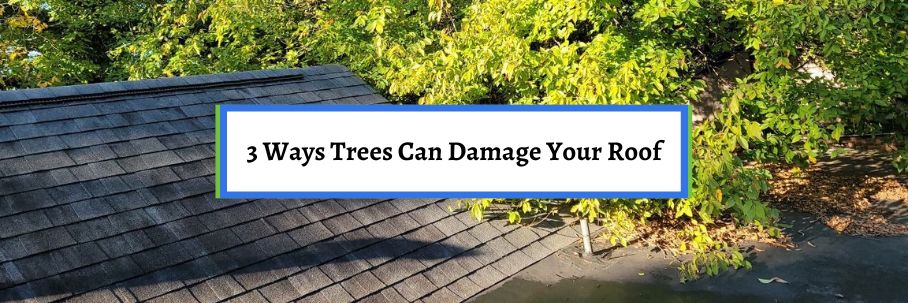
3 ways trees can damage your roof
Trees damage your roof in a few different ways:
1. A tree or tree limbs falling on a roof.
2. Overhanging tree limbs eroding asphalt shingles.
3. Leaks caused by sitting debris on your roof.
Most homes around the country have trees on their property. But while they’re great to look at, they cause problems when they’re close to your home.
In fact, the trees around your home could be causing serious roof damage without you knowing it. Unfortunately, finding out usually comes with a price tag.
So, how do trees damage a roof? And is it possible to prevent trees from damaging your roof?
For over 30 years, the team at Bill Ragan Roofing has helped homeowners understand how to maximize their roof investment. Because of this, I’ll answer the previous questions.
This article covers the following:
- 3 ways trees can damage your roof
- How to prevent tree damage to your roof
3 ways trees can damage your roof
There are a few different ways trees damage roofs. While one may be obvious, most homeowners have no idea about the other two.
However, they all cause damage in their own way and shorten your roof’s life. Let’s get to it.
1. Damage from a tree or tree limbs falling on a roof
The first way a tree can damage your roof is when it or a tree limb physically falls on your roof. This is probably what most people think of when they hear “tree damage”.
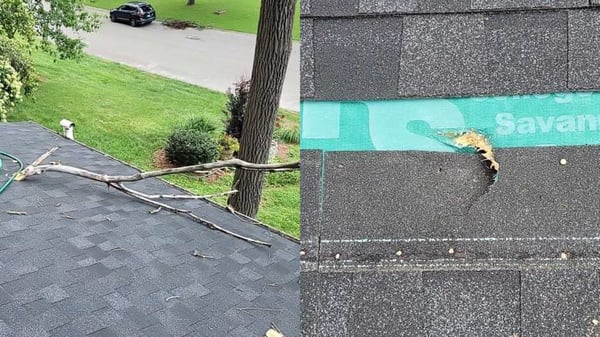 (Left: tree limb that fell on a roof; Right: roof puncture from the fallen limb)
(Left: tree limb that fell on a roof; Right: roof puncture from the fallen limb)
A single fallen tree limb can cause enough structural damage to go through a roof. So, I’m sure you can imagine what happens when an entire tree falls on your roof.
Most of the time, a fallen tree is enough to cause serious structural damage. Fortunately, there are cases when a tree falls on a roof without going through it.
While this may not cause structural issues, it’ll still damage your roofing material and components. So, it’s a good idea to call a roofer to assess the situation even if a fallen tree or tree limb didn’t go through your roof.
2. Overhanging tree limbs erode and damage asphalt shingles
The first way a tree can damage your roof isn’t from the tree itself but the limbs overhanging it. The main thing to worry about is the continuous drips of water every time it rains.
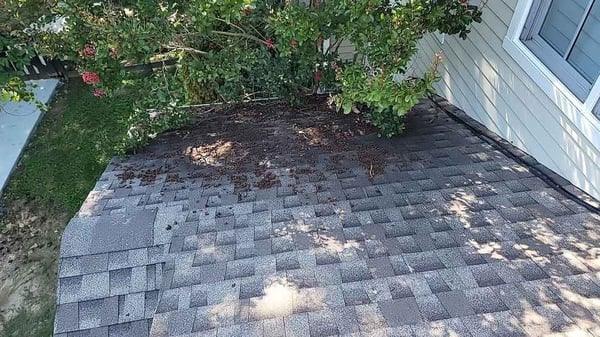
This erodes your asphalt shingles’ protective layer over time, which shortens their lifespan. While dripping water is a problem, you also have to worry about bird droppings.
Bird droppings are highly acidic and actually eat away at asphalt shingles. Like constant water dripping, continuous bird droppings will shorten your roof’s life.
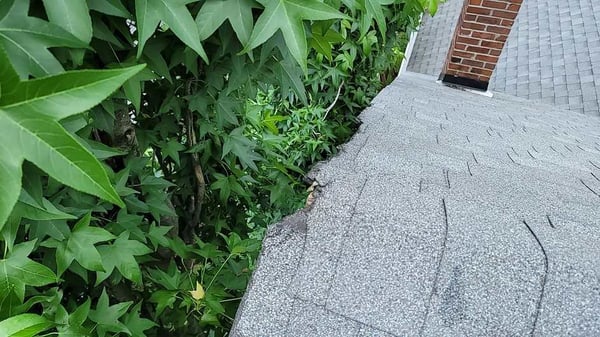
The stuff coming off tree limbs is a problem, but so are the limbs if they’re touching the roof. Over time, the constant rubbing between the limb and asphalt shingles damages them beyond repair.
3. Leaks caused by sitting leaves, sticks, and other debris
The last way a tree can damage your roof is when fallen leaves, sticks, seedlings, etc., are allowed to sit on your roof. This way could play into overhanging limbs, but debris can make it to your roof no matter where trees are on your property.
While sitting debris anywhere on your roof is a problem, the main concern is in your roof valleys. A literal dam is created with the debris that doesn’t allow water to flow down your roof properly.
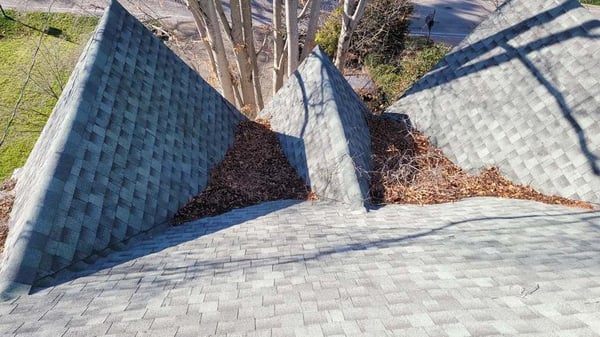
This causes water to back up before eventually finding the path of least resistance, which leads to leaks. There's also the issue of debris becoming saturated and sitting in the valley.
The longer the saturated debris is allowed to sit, the more damage it does.
How do you prevent tree damage to your roof?
Now you know the 3 ways trees can damage your roof. But how do you prevent tree damage from happening in the first place?
The best thing you can do is completely remove the tree(s) around your home if you really want to avoid tree damage altogether. However, removing trees is an expensive project most homeowners avoid; some even like trees on the property.
With that out as an option, the next best thing is keeping your tree limbs trimmed back. This ensures they no longer hang directly over or touch your roof.
Unfortunately, this still leaves debris in roof valleys or other roof areas. The best way to avoid sitting debris is by getting annual roof maintenance.
Roof maintenance is crucial to ensure your roof reaches its maximum lifespan, and clearing it of debris is a big part of that. The great thing is that this can happen on a scheduled yearly basis by signing up for a roofing contractor’s maintenance plan.
Does homeowners insurance cover tree damage to your roof?
After reading this article, you now know how trees damage a roof and what you can do to prevent it. The best way to avoid these problems is by keeping your trees trimmed.
However, even this doesn't completely prevent tree damage to your roof. If it does happen, you’ll either have to get repairs or even a full replacement if the damage is widespread and bad enough.
Unfortunately, this can be painful for your wallet. But what about homeowners insurance? Shouldn’t it cover tree damage to your roof?
The truth is, it depends on the situation. Which is why I wrote another article breaking it down.
Check out Does Homeowners Insurance Cover Roof Damage From Trees to learn if you have an insurance claim for the tree damage to your roof.


